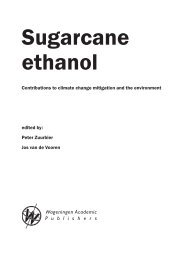Production and use of fuel ethanol in Brazil - BAFF
Production and use of fuel ethanol in Brazil - BAFF
Production and use of fuel ethanol in Brazil - BAFF
Create successful ePaper yourself
Turn your PDF publications into a flip-book with our unique Google optimized e-Paper software.
exported by sugar <strong>and</strong> <strong>ethanol</strong> plants <strong>in</strong> the future (thereby improv<strong>in</strong>g the current<br />
processes). One <strong>of</strong> the ma<strong>in</strong> advantages to us<strong>in</strong>g the bagasse is that it does not result<br />
<strong>in</strong> emissions <strong>of</strong> sulphur compounds (SOx) <strong>in</strong> the atmosphere.<br />
In order to regulate the emission <strong>of</strong> atmospheric pollutants from <strong>in</strong>dustrial sources,<br />
the National Environment Council has passed CONAMA Resolution no. 382/2006.<br />
Concern<strong>in</strong>g emissions from boilers where sugar-cane bagasse is burned to generate<br />
thermal energy, it sets limits on the emission <strong>of</strong> particulate matter <strong>and</strong> nitrogen<br />
oxides. These requirements apply nationwide, but the Resolution provides that the<br />
state agencies may apply more restrictive limits, where necessary.<br />
Nom<strong>in</strong>al Thermal Power (MW) PM (1) NOx (1)<br />
Less than 10 280 N.A.<br />
Between 10 <strong>and</strong> 75 230 350<br />
More than 75 200 350<br />
B. Sugar-cane <strong>and</strong> <strong>ethanol</strong> production: environmental aspects<br />
(As NO 2 )<br />
(1) Results shall be expressed as concentration <strong>in</strong> mg/Nm³, dry basis <strong>and</strong> 8 percent excess<br />
oxygen.<br />
N.A. - Not Applicable<br />
B2.7.<br />
What are the regulations for the <strong>use</strong> <strong>of</strong> water<br />
<strong>in</strong> the <strong>in</strong>dustrial process<strong>in</strong>g <strong>of</strong> sugar-cane <strong>in</strong>to<br />
<strong>ethanol</strong> <strong>and</strong> sugar?<br />
The sugar-cane <strong>in</strong>dustry <strong>in</strong> the Center-South region <strong>of</strong> <strong>Brazil</strong> displays an extremely<br />
low mean consumption <strong>of</strong> water per ton <strong>of</strong> sugar-cane produced <strong>and</strong> processed<br />
(compared to other regions around the world). Practically all <strong>in</strong>dustrial systems are<br />
closed, with a high recycl<strong>in</strong>g level. In agriculture, sugar-cane crops are not irrigated<br />
(almost all <strong>of</strong> the water they <strong>use</strong> is ra<strong>in</strong> water) (see item B3.1).<br />
47












